"From the earliest days of contact with the native peoples of North America, European artists made images illustrating their customs, dress and living spaces. Some of the drawings showed the natives as curious specimens from another world, with peculiar habits and clothing. Others emphasized their skill at hunting or their ferocity as warriors. While some images accompanied sensationalist accounts of Indian raids on white settlers, others attempted to expose cruelties that whites had inflicted on native peoples.
This selection of illustrations from books, maps and serials shows some of the variety of approaches that European and European-American artists took in depicting the Indians of North America, from the 16th to the 19th century."
[Illustrations of American Indians collection at Beinecke Rare Books & Manuscripts Library, Yale University]

Indigenous weaponry
IN: 'Histoire de la Virginie...' by Robert Beverley, 1707.
"In the original edition [1705, in English] Beverley combined shrewd insights into the Virginia of his day, sharp comments about the colony's leaders, and vivid descriptions of the natural world, all written with an engaging enthusiasm for his native land.
Though a section on Virginia's early history is cursory, the book as a whole remains important. Beverley drew on John Smith's 'General History of Virginia' but sketched the colony's development to 1704, incorporating valuable observations of his own.
The author's descriptive powers are best revealed in the section on the culture of Native Americans in Virginia. This sympathetic account presents the Native Americans 'in their simple state of nature, and in their enjoyment of plenty, without the curse of labour', an existence which Beverley himself appeared to envy."
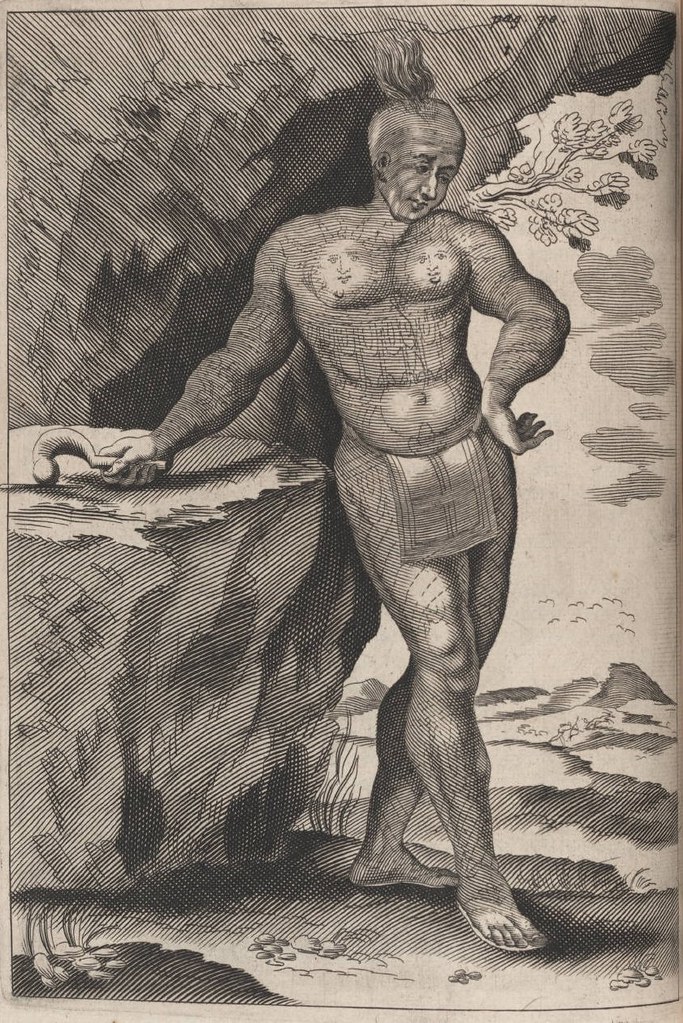
Engraving of a heavily tattooed North American Indian wearing a loincloth
IN: 'Historiae Canadensis, seu Novae-Franciae Libri decem, ad annum usque Christi MDCLVI' by Francois du Creux', 1664.
(New France ~~ Canada; Jesuit report)
Du Creux never visited Canada himself and the illustrations in the book are said to have been based on drawings from the mysterious Codex Canadensis :: previously.
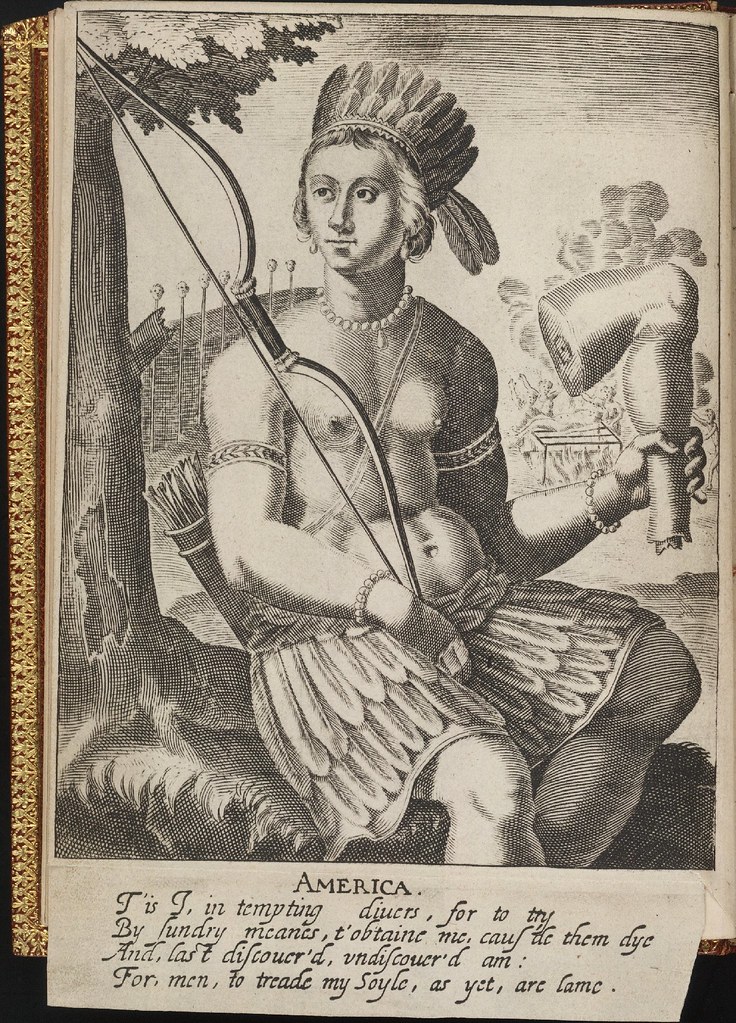
America.
T'is I, in tempting divers, for to try
By ſundry meanes, t'obtaine me, cauſ'de them dye
And, last diſcover'd, undiſcover'd am:
For, men, to treade my ſoyle, as yet, are lame
IN: 'America painted to the life. The true history of the Spaniards proceedings in the conquests of the Indians, and of their civil wars among themselves, from Columbus his first discovery, to these later times. As also, of the original undertakings of the advancement of plantations into those parts; with a perfect relation of our English discoveries, shewing their beginning, progress and continuance, from the year 1628. to 1658. Declaring the forms of their government, policies, religions, maners [!], customs, military discipline, wars with the Indians, the commodities of their countries, a description of their towns and havens, the increase of their trading, with the names of their governors and magistrates. More especially, an absolute narrative of the north parts of America, and of the discoveries and plantations of our English in Virginia, New-England, and Berbadoes' by Ferdinando Gorges, 1658-59.
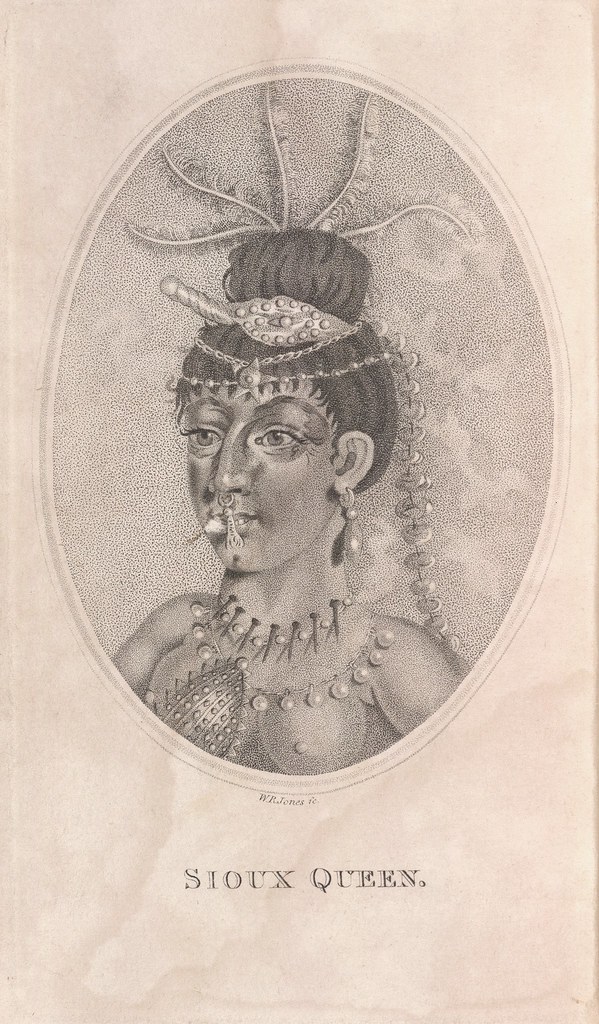
Sioux Queen
IN: 'The Travels of Capts. Lewis & Clarke, by order of the government of the United States, performed in the years 1804, 1805, & 1806, being upwards of three thousand miles, from St. Louis, by way of the Missouri, and Columbia rivers, to the Pacifick Ocean: containing an account of the Indian tribes, who inhabit the western part of the continent unexplored, and unknown before. With copious delineations of the manners, customs, religion, &c. of the Indians..' - published in 1809 by Lester Hubbard.
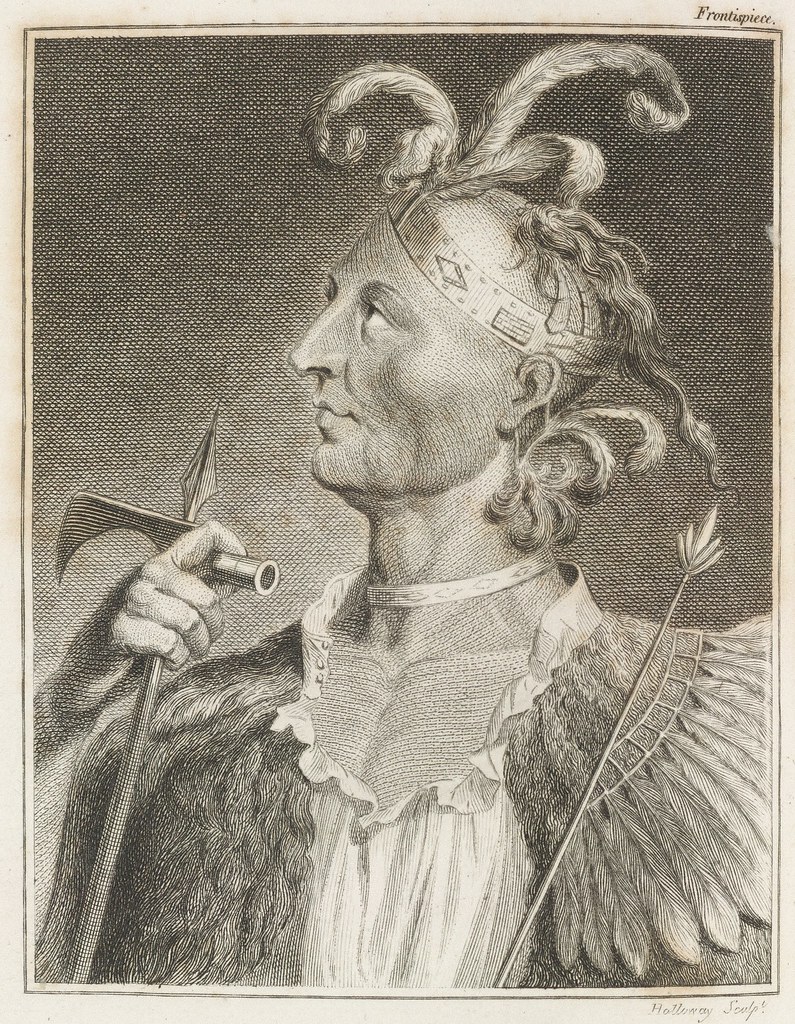
Mico Chlucco the Long Warrior, or King of the Siminoles
Frontispiece from 'Travels through North and South Carolina, Georgia, East and West Florida, the Cherokee country, the extensive territories of the Muscogulges or Creek confederacy, and the country of the Chactaws. Containing an account of the soil and natural productions of those regions; together with observations on the manners of the Indians' by William Bartram, 1792.
This illustration was re-purposed in 1809 as a Sioux warrior in 'The Travels of Capts. Lewis & Clarke' [see above]; pub. by H Lester.
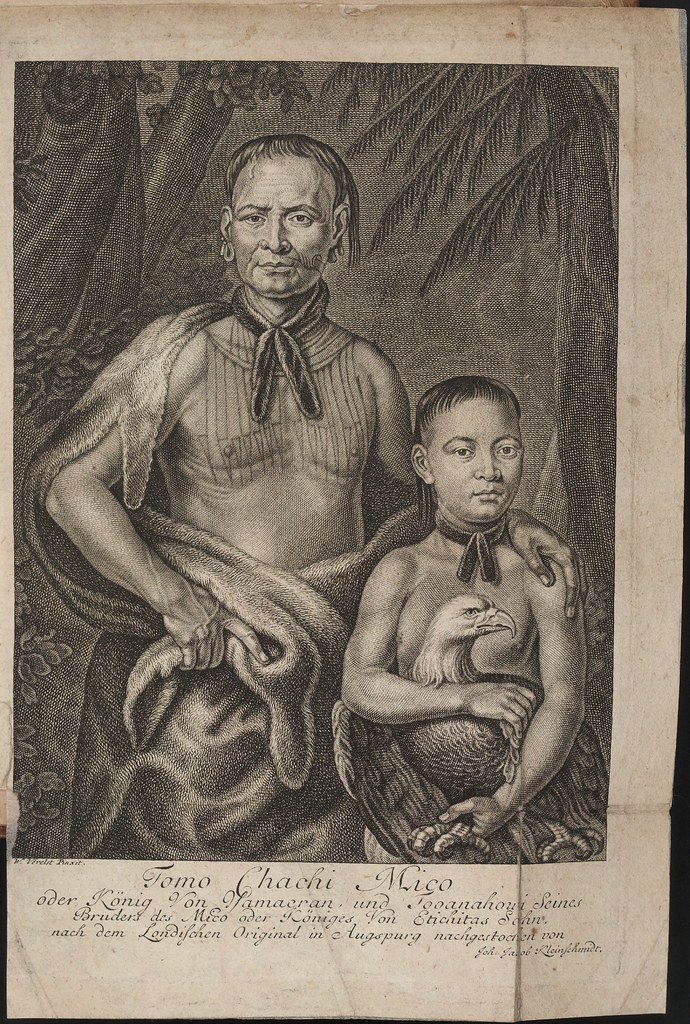
Tomo Chachi Mico oder Koenig von Yamacran, und Tooanahowi
Seines Bruders des Mico oder Koeniges von Etichitas Sohn
[The frontispiece represents "Tomo Chachi Mico," King of Yamacran,
and his brother's, the King of Etichitas' son, "Tooandhowi."]
Seines Bruders des Mico oder Koeniges von Etichitas Sohn
[The frontispiece represents "Tomo Chachi Mico," King of Yamacran,
and his brother's, the King of Etichitas' son, "Tooandhowi."]
IN: 'Der ausführlichen nachrichten von der königlich-gross-britannischen colonie saltzburgischer emigranten in America erster [bis dritter] theil...' by Samuel Urlsperger, 1735. [~News of the Salzburg emigrants to the British colony in America]
Tomochachi assisted General James Edward Oglethorpe in establishing the British colony in Georgia. In 1734, he accompanied General Oglethorpe on a trip to London where his portrait was painted by Willem Verelst.
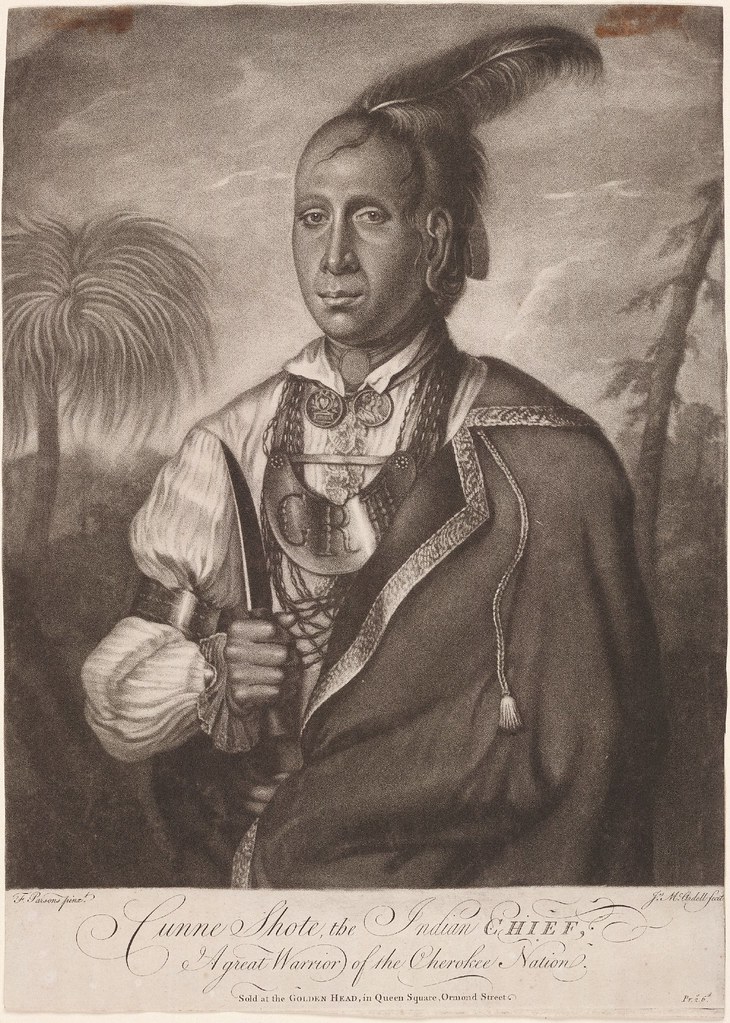
Cunne Shote, the Indian chief, a Great Warrior of the Cherokee Nation
This mezzotint engraving was done by James McArdell in ~1762 after a painting by Francis Parsons.
Cunne Shote, was one of three Cherokee chiefs who travelled to London in 1762 to see King George III.
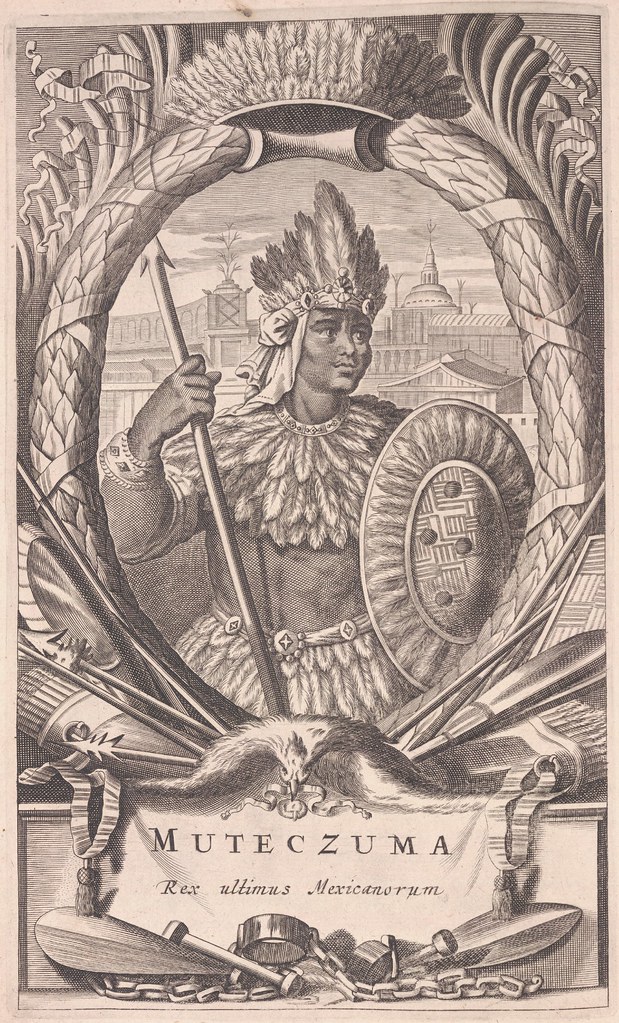
Muteczuma Rex ultimus Mexicanorum
[Montezuma II, Emperor of Mexico, ~1480-1520]
[Montezuma II, Emperor of Mexico, ~1480-1520]
IN: 'America: being the latest, and most accurate description of the New world; containing the original of the inhabitants, and the remarkable voyages thither. The conquest of the vast empires of Mexico and Peru, and other large provinces and territories, with the several European plantations in those parts. Also their cities, fortresses, towns, temples, mountains, and rivers. Their habits, customs, manners, and religions. Their plants, beasts, birds, and serpents. With an appendix, containing, besides several other considerable additions, a brief survey of what hath been discover’d of the unknown south-land and the Arctick region. Collected from most authentick authors..' by John Ogilby, 1671.
"Apparently based in part on Arnoldus Montanus's 'De Nieuwe en onbekende weereld: of beschryving van America en't zuid-land', which was granted copyright privileges in July, 1670, and published in Amsterdam in 1671. Sabin, who records an edition of Ogilby as bearing date of 1670, says: "This English translation is, like Dapper's 'an impudent plagiarism' from Montanus, plates included." "
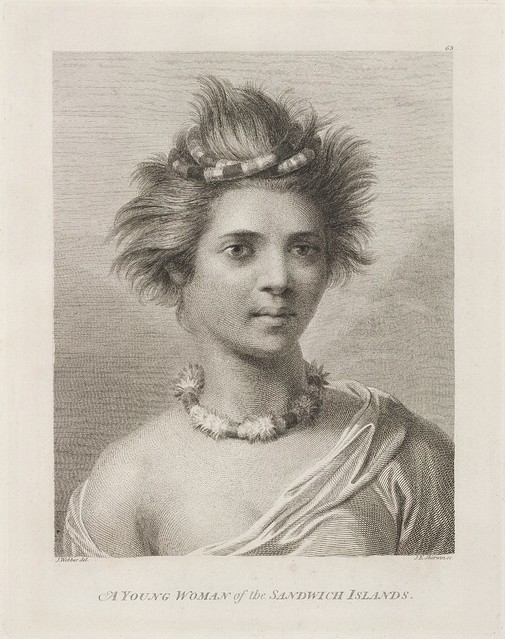
A young woman of the Sandwich Islands (Hawaii)
IN: 'A voyage to the Pacific Ocean. Atlas of plates' (Captain Cook's 3rd voyage), 1784.
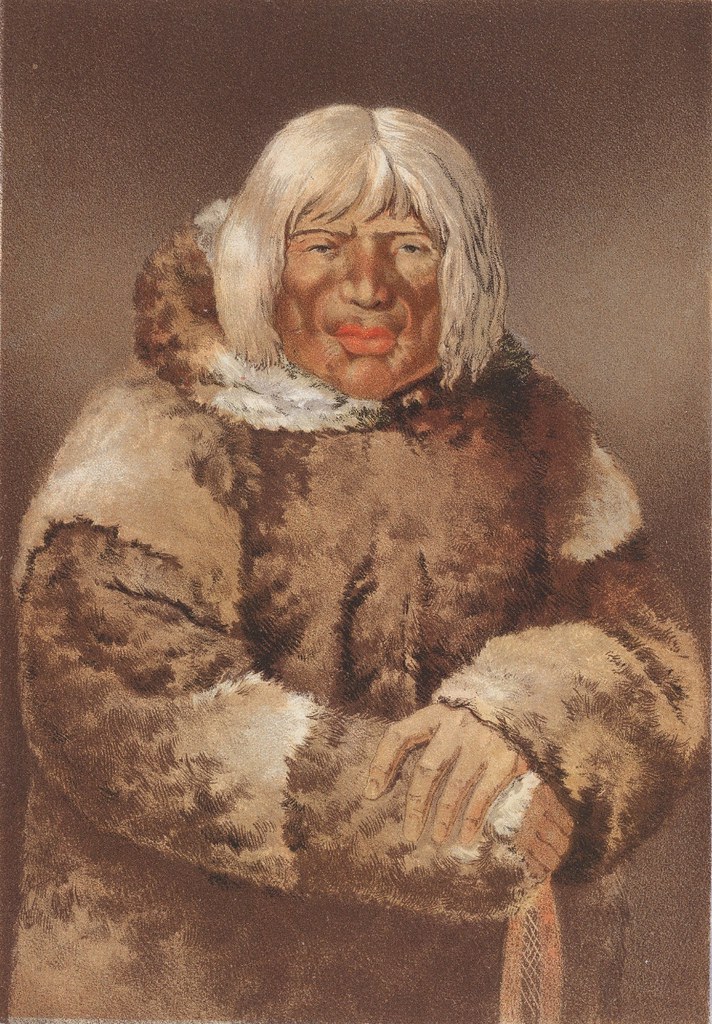
Portrait of an Esquimaux
IN: 'Wanderings of an artist among the Indians of North America : from Canada to Vancouver’s Island and Oregon, through the Hudson’s Bay company’s territory and back again' by Paul Kane and Vincent Brooks, 1859.
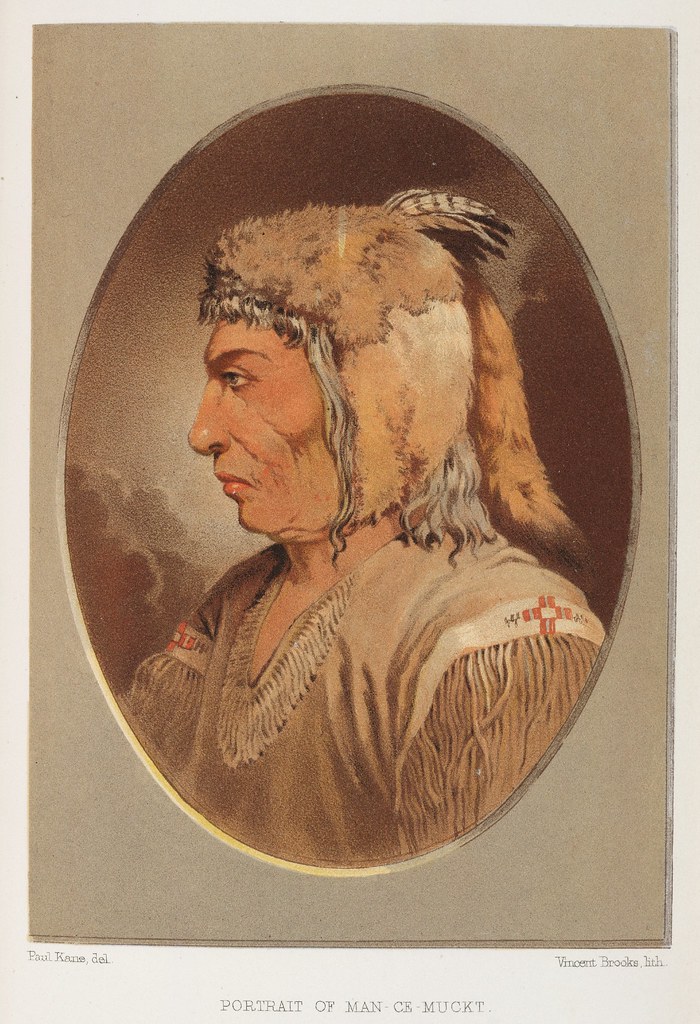
Portrait of Man-Ce-Muckt
Chromolithograph from: 'Wanderings of an artist among the Indians of North America : from Canada to Vancouver’s Island and Oregon, through the Hudson’s Bay company’s territory and back again' by Paul Kane, 1859.
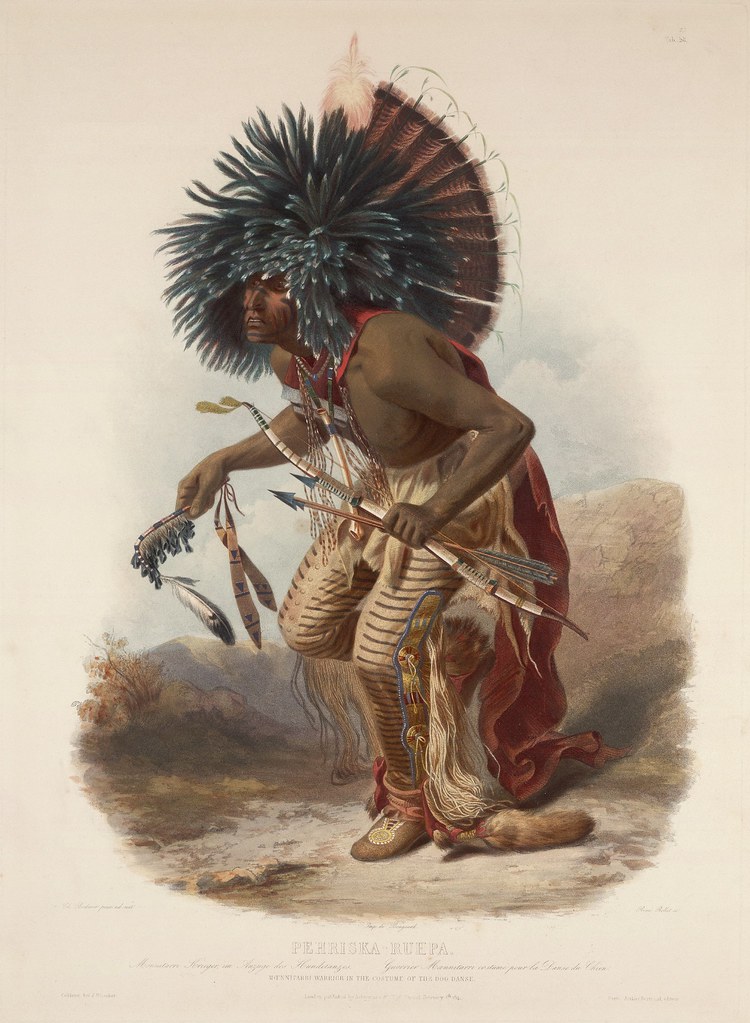
Pehriska Ruppa in the costume of the Dog-band.
Illustrated by Karl Bodmer, the plate appears in 'Reise in das innere Nord-America' [Travels in the interior of North America] by Maximilian, Prince of Wied, 1840. [previously]
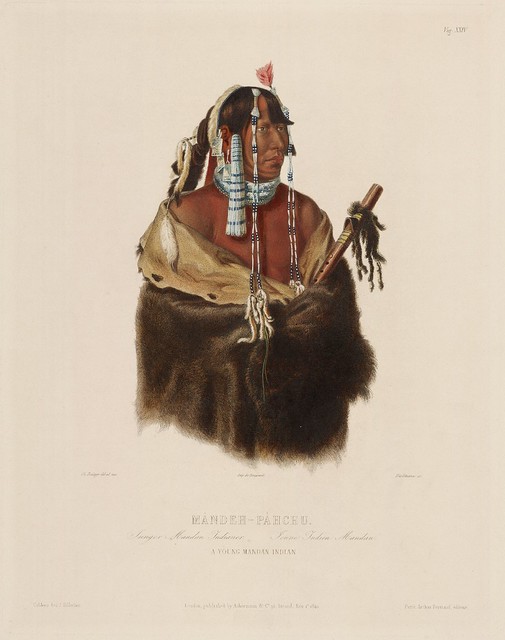
Mandeh Pahchu, a Mandan Indian
Illustrated by Karl Bodmer, the plate appears in 'Reise in das innere Nord-America' [Travels in the interior of North America] by Maximilian, Prince of Wied, 1840.
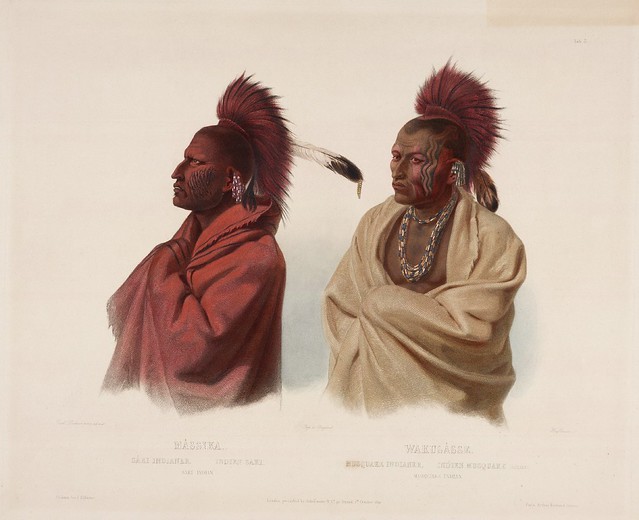
Massica & Wakusasse, a Saukie and a Fox Indian
Illustrated by Karl Bodmer, the plate appears in 'Reise in das innere Nord-America' [Travels in the interior of North America] by Maximilian, Prince of Wied, 1840.
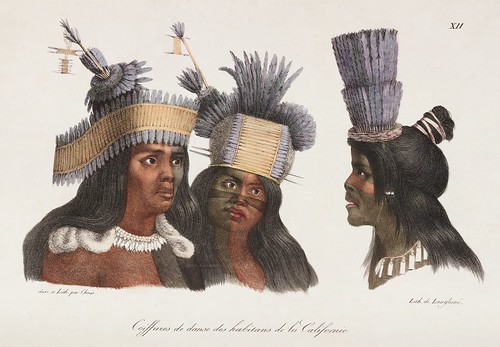
Coiffures du danse des habitans de la Californie
[~customary Californian head wear for dancing]
[~customary Californian head wear for dancing]
IN: 'Voyage pittoresque autour du monde, avec des portraits de sauvages d’Amerique, d’Asie, d’Afrique...' by Louis Choris, 1822. (previously)
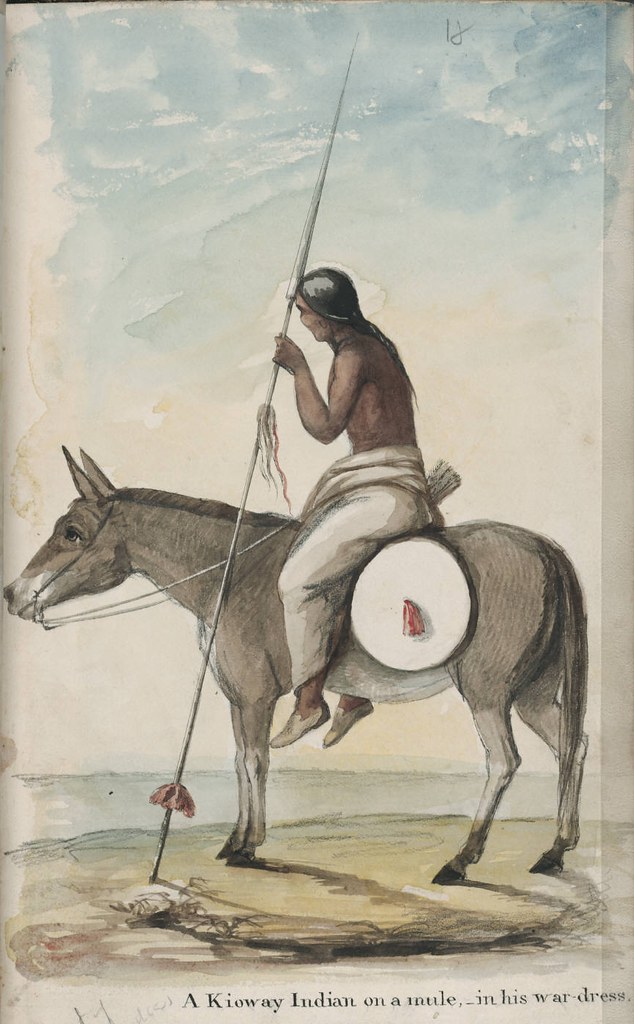
A Kioway* Indian on a mule, in his war-dress
In a publication by the Army. Corps of Topographical Engineers: 'Message from the president of the United States : in compliance with a resolution of the Senate, communicating a report of an expedition led by Lieutenant Abert, on the upper Arkansas and through the country of the Camanche Indians, in the fall of the year 1845'.
"Twenty-four years old and three years out of West Point, James W. Abert was assigned to John C. Frémont's third expedition in May, 1845. By September, Frémont had gained sufficient confidence in the young lieutenant to place him in charge of a difficult reconnaissance through potentially hostile Indian country.
Abert's official report exudes the youthful enthusiasm he brought to the task. It was illustrated with lithographs based on sketches he made in the field, but Abert enhanced his personal copy, shown here, with finished watercolors of many of the Native Americans he encountered. Among the earliest images of Southern Plains Indians known to exist, the watercolors heighten the drama of Abert's foray into uncharted country."
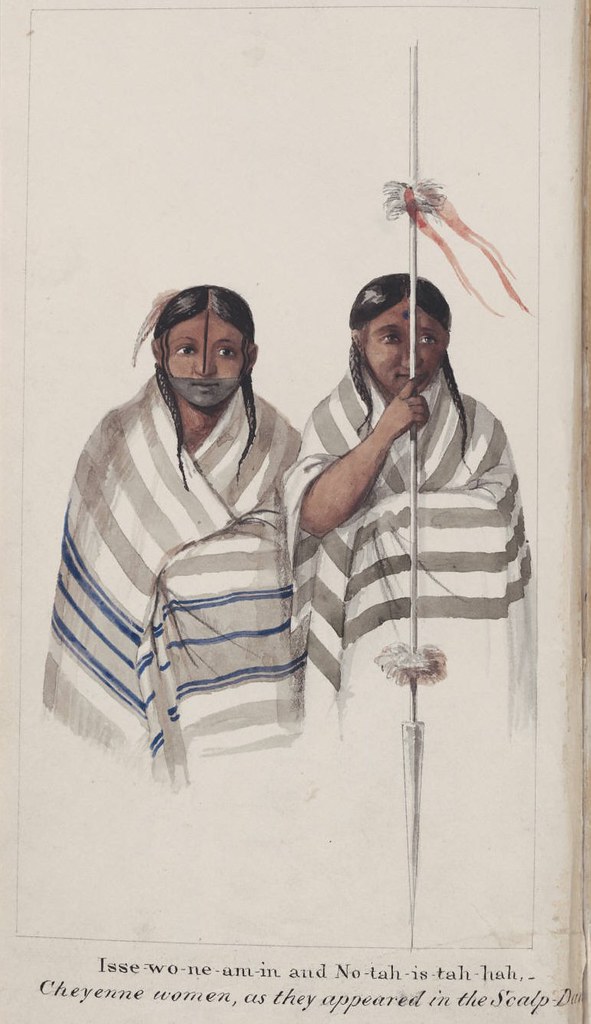
Isse-wo-ne-am-in and No-tah-is-tah-hah,
Cheyenne women, as they appeared in the Scalp-Dance
Cheyenne women, as they appeared in the Scalp-Dance
Army. Corps of Topographical Engineers: 'Message from the president of the United States...', 1845.
[Some of the images have been cropped from the full page and slightly background cleaned. Click through to greatly enlarged versions (in some cases) - Beinecke provides fabulous .sid files {'zoom'} for many of the images which convert from modest downloads to enormous jpegs]
Illustrations of American Indians: "Just under 300 engravings, watercolors, and illustrations drawn from books, archival collections, and artwork from the Beinecke Library's Western Americana and General collections".
Via the Beinecke Library blog || previously: America / ethnology